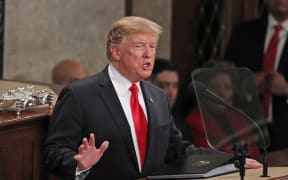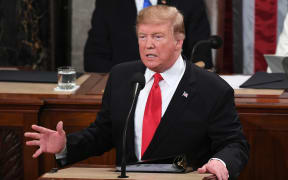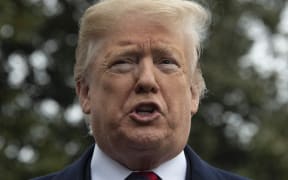President Donald Trump exaggerated perils at the border, flubbed food stamp numbers and the length of wars and told partial truths on drug prices in his State of the Union speech.
He also celebrated a couple of workforce measures that have little to do with him and almost everything to do with a growing population.
However in a response to the speech, Democratic politician Stacey Abrams reflected a recent and misleading talking point by her party when she slammed the Trump administration for choosing to "cage children" at the border, ignoring a practice also employed by the Obama administration to hold migrant children in facilities with chain-link fencing.
Here's a look at some of the statements from State of the Union night:
Labour force
Trump: "All Americans can be proud that we have more women in the workforce than ever before."
"More people are working now than at any time in the history of our country, 157 million people at work."
The facts: Yes, but that's because the population has grown. It's more than doubled since 1950 and, in recent months, it's been increasing by 150,000 to nearly 200,000 per month.
Births are the primary driver of population growth, with immigration also contributing. In 2030, that's expected to change, with immigration overtaking the natural increase from births exceeding deaths.
As for women, the big question is whether greater percentages of them are working or searching for a job than at any point in history. And on this count, women have enjoyed better times.
Women's labor force participation rate right now is 57.5 percent, according to the US Labor Department. The rate has ticked up recently, but it was higher in 2012 and peaked in 2000 at roughly 60 percent.
Overall, 63.2 percent of Americans are working or looking for work. That's a few ticks higher than when Mr Trump was inaugurated, when it was 62.9 percent, but far below the 2000 peak of 67.3 percent. The rate has declined partly because of aging as a wave of baby boomers retire, but even among younger workers it's below where it was nearly two decades ago.
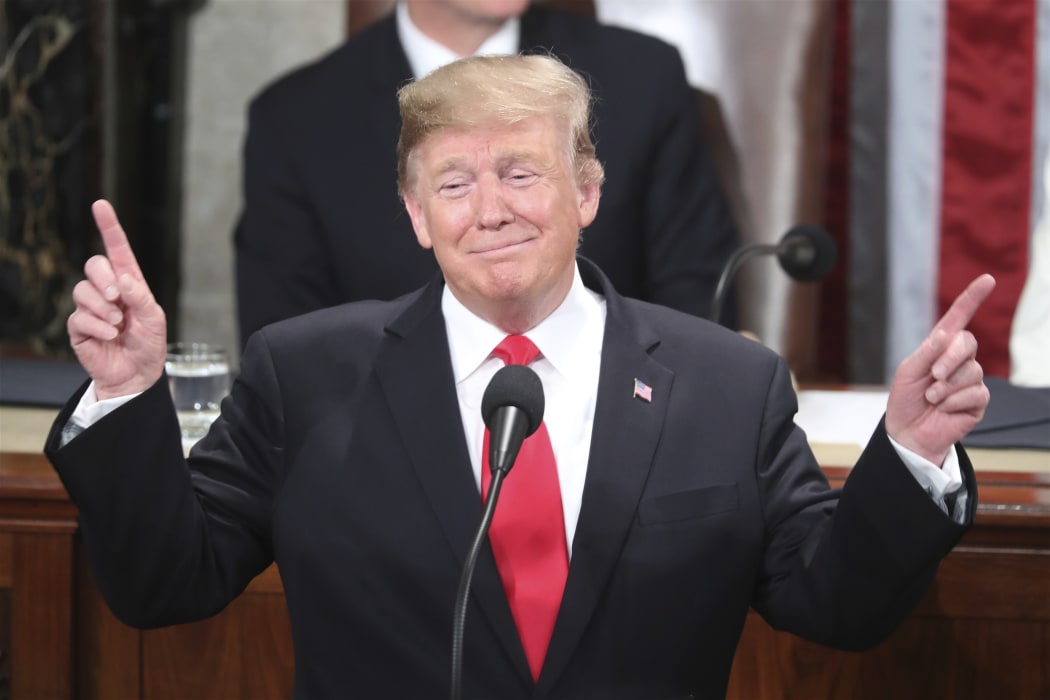
Photo: AP Photo / Andrew Harnik
Border, El Paso
Trump: "The border city of El Paso, Texas, used to have extremely high rates of violent crime, one of the highest in the entire country and considered one of our nation's most dangerous cities. Now, immediately upon its building, with a powerful barrier in place, El Paso is one of the safest cities in our country. Simply put, walls work and walls save lives."
The facts: That's a distorted picture of El Paso, where Trump is going to showcase his push for a border wall.
El Paso has never been considered one of the nation's most dangerous cities. In fact, its murder rate was less than half the national average in 2005, the year before the start of its border fence. The city has experienced ebbs and flows in violent crime but they have largely mirrored national trends and been under national averages for decades.
Border security
Trump: "The lawless state of our southern border is a threat to the safety and security and financial well-being of all America."
The facts: Whether the border is sufficiently secure or not cuts to the core of a heated national debate, but it's far from lawless. The number of people arrested for crossing illegally has plunged in the last decade and is near its lowest level since the mid-1990s, illustrating a substantial downward trend in the number of migrants trying to sneak in. Border Patrol personnel, detection technology and physical barriers have increased in that time.
Do walls work?
Trump: "These (border) agents will tell you where walls go up, illegal crossings go way, way down ... San Diego used to have the most illegal border crossings in our country. In response, a strong security wall was put in place. This powerful barrier almost completely ended illegal crossings ... Simply put, walls work and walls save lives."
The facts: It's a lot more complicated than that.
Yes, Border Patrol arrests in the San Diego sector plummeted 96 percent from nearly 630,000 in 1986 to barely 26,000 in 2017, a period during which walls were built. But the crackdown pushed illegal crossings to less-patrolled and more remote Arizona deserts, where thousands died in the heat. Arrests in Tucson in 2000 nearly matched San Diego's peak.
Critics say the "water-balloon effect" - build a wall in one spot and migrants will find an opening elsewhere - undermines Trump's argument, though proponents say it only demonstrates that walls should be extended.
The Government Accountability Office reported in 2017 that the U.S. has not developed metrics that demonstrate how barriers have contributed to border security.
Legal immigration
Trump: "I want people to come into our country in the largest numbers ever but they have to come in legally."
The facts: His policy recommendations to date do not reflect this wish.
The plan he proposed upon taking office would have sharply limited the ability of citizens and permanent residents to bring in family, which he derisively called "chain migration." The Cato Institute, which favors more open immigration policies, estimated his plan would cut the number of legal immigrants by up to 44 percent, the largest cut to legal immigration since the 1920s.
According to data from the Homeland Security Department, about 750,000 of more than 1.1 million people who obtained green cards in 2017 - or two-thirds - did so through family relations. Mr Trump's plan called for limiting family-based green cards to spouses and minor children of US citizens and green card holders, a dramatic cut. He's also slashed the number of refugees the US will accept for two straight years and he wants to eliminate diversity visas.
He's talked about switching to merit-based, instead of family-based, immigration and said at times that he wants to make it easier for temporary workers to work and graduates from top colleges to stay in the country. But researchers have said the net effect of his proposals would be fewer legal immigrants.
Middle East wars
Trump: "Our brave troops have now been fighting in the Middle East for almost 19 years."
The facts: Trump exaggerated the length of the wars in Iraq and Afghanistan. The war in Afghanistan began in October 2001, in the aftermath of the 11 September attacks. The invasion of Iraq was in March 2003. The US has been at war for a bit more than 17 years.
Also, he refers to fighting in the Middle East. Iraq is in the Middle East, but Afghanistan is in central Asia.
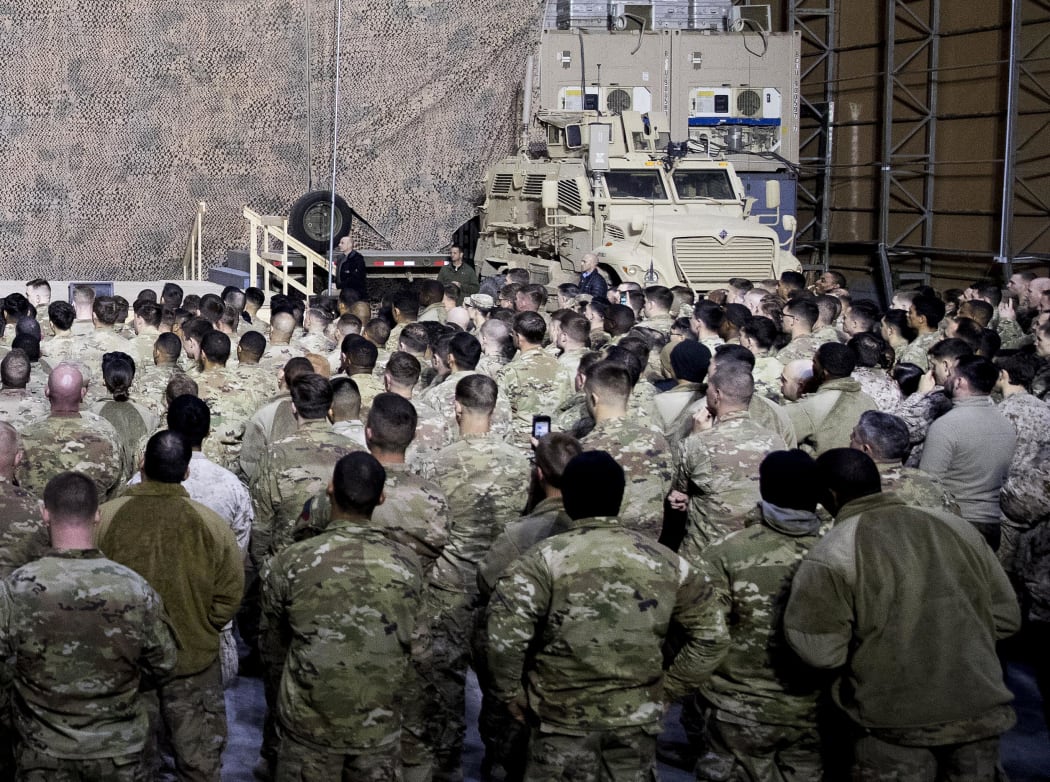
US troops listen to President Donald Trump speak at a hangar rally at Al Asad Air Base, Iraq. Photo: AP Photo / Andrew Harnik
Food stamps
Trump, describing progress over the last two years: "Nearly 5 million Americans have been lifted off food stamps."
The facts: The number of people receiving food stamps actually hasn't declined that much.
Government data show there were 44.2 million people participating in the Supplemental Nutrition and Assistance Program in 2016, before Mr Trump took office. In 2018, there were 40.3 million people participating in SNAP. That's a decline of 3.9 million, not the 5 million Mr Trump talked about.
The number of people participating in the SNAP program peaked in 2013 and has been going down since that time.
Mr Trump's last budget proposed cutting SNAP by $213 billion over 10 years. The administration also has been pushing to give states more flexibility in implementing the program, including tightening work requirements for recipients.
Abrams - economy
Abrams: "The Republican tax bill rigged the system against working people. Rather than bringing back jobs, plants are closing, layoffs are looming and wages struggle to keep pace with the actual cost of living."
The facts: The economy is doing better after the introduction of the Trump administration's tax cuts than Abrams suggests. The number of people seeking unemployment benefits, a proxy for layoffs, briefly fell to a five-decade low last month. Average hourly pay is running ahead of inflation.
Tariffs
Trump: "We recently imposed tariffs on $250 billion of Chinese goods - and now our treasury is receiving billions of dollars."
The facts: This is misleading. Yes, money from tariffs is going into the federal treasury, but it's largely coming from US businesses and consumers. It's not foreign countries that are paying these import taxes by cutting a cheque to the government.
Mr Trump's reference to money coming into the treasury "now" belies the fact that tariffs go back to the founding of the country. This revenue did not start with his increased tariffs on some goods from China.
Tariffs did produce $41.3 billion in tax revenues in the last budget year, according to the Treasury Department. But that is a small fraction of a federal budget that exceeds $4.1 trillion.
The tariffs paid by US companies also tend to result in higher prices for consumers, which is what happened for washing machines after the Trump administration imposed import taxes.
Trade - NAFTA
Trump: "Our new US-Mexico-Canada Agreement - or USMCA - will replace NAFTA and deliver for American workers: bringing back our manufacturing jobs, expanding American agriculture, protecting intellectual property, and ensuring that more cars are proudly stamped with the four beautiful words: MADE IN THE USA."
The facts: It's unlikely to do all those things, since the new agreement largely preserves the structure and substance of NAFTA. In addition, the deal has not been ratified and its chances in Congress are uncertain.
In one new feature, the deal requires that 40 percent of cars' contents eventually be made in countries that pay autoworkers at least $16 an hour - that is, in the United States, or Canada, but not in Mexico. It also requires Mexico to pursue an overhaul of labor law to encourage independent unions that will bargain for higher wages and better working conditions for Mexicans.
Still, just before the agreement was signed, General Motors announced that it would lay off 14,000 workers and close five plants in the US and Canada.
Philip Levy, senior fellow at the Chicago Council on Global Affairs and a trade official in Republican President George W Bush's White House, says: "President Trump has seriously overhyped this agreement."
Drug pricing
Trump: "Already, as a result of my administration's efforts, in 2018 drug prices experienced their single largest decline in 46 years."
The facts: Trump is selectively citing statistics to exaggerate what seems to be a slowdown in prices. A broader look at the data shows that drug prices are still rising, but more moderately. Some independent experts say criticism from Trump and congressional Democrats may be causing pharmaceutical companies to show restraint.
The Consumer Price Index for prescription drugs shows a 0.6 percent reduction in prices in December 2018 compared to December 2017, the biggest drop in nearly 50 years. The government index tracks a set of medications including brand drugs and generics.
However, that same index showed a 1.6 percent increase when comparing the full 12 months of 2018 with the entire previous year.
"The annualized number gives you a better picture," said economist Paul Hughes-Cromwick of Altarum, a nonprofit research organization. "It could be that something quirky happened in December."
Separately, an analysis of brand-name drug prices by The Associated Press shows there were 2712 price increases in the first half of this January, as compared with 3327 increases during the same period last year.
The size of this year's increases was not as pronounced. Both this year and last, the number of price cuts was minuscule.
The information for the analysis was provided by health data firm Elsevier.

(file photo) Photo: AP Photo / Rich Pedroncelli
Wages
Trump: "Wages are rising at the fastest pace in decades, and growing for blue collar workers, who I promised to fight for, they're growing faster than anyone else thought possible."
The facts: This is an unsupported statement because the data on hourly wages for private workers only go back to 2006, not decades.
But data on wages for production workers date back to 1939 - and Trump's claim appears to be unfounded.
Average hourly earnings for production and nonsupervisory workers are up 3.4 percent over the past year, according to the Labor Department. Those wage gains were higher as recently as early 2009. And they were averaging roughly 4 percent before the start of the Global Financial Crisis in late 2007.
There are other ways to track wage gains - and those don't work in Trump's favor, either.
Adjusted for inflation, median weekly wages rose just 0.6 percent in 2018. The gains in weekly wages were 2.1 percent in 2015.
Abrams - Migrant children
Abrams, in the Democratic response: "We know bipartisanship could craft a 21st century immigration plan but this administration chooses to cage children and tear families apart."
The facts: The cages that Abrams mentions are actually chain-link fences and the Obama administration used them, too.
Children are held behind them, inside holding Border Patrol facilities, under the Trump administration. As well, Obama's administration detained large numbers of unaccompanied children inside chain link fences in 2014. Images that circulated online of children in cages during the height of Trump's family separations controversy were actually from 2014 when President Barack Obama was in office.
Children are placed in such areas by age and sex for safety reasons and are held for up to 72 hours by the Border Patrol.
The Department of Homeland Security inspector general visited five detention facilities for unaccompanied children on the Texas border with Mexico in late June, during the height of the furor over family separations, and found they appeared to comply with detention standards. The government watchdog reported that cleanliness was inconsistent but that the children had access to toilets, food, drinks, clean bedding and hygiene items.
At the height of the family separations, about 2,400 children were separated. Since then, 118 children were separated. Immigration officials are allowed to take a child from a parent in certain cases - serious criminal charges against a parent, concerns over the health and welfare of a child or medical concerns.
That policy has long been in place and is separate from the now-suspended zero-tolerance Trump administration policy that saw children separated from parents only because they had crossed illegally.
Minority unemployment
Trump: "African-American, Hispanic-American and Asian-American unemployment have all reached their lowest levels ever recorded."
The facts: What he's not saying is that the unemployment rates for all three groups have gone up since reaching record low levels.
Black unemployment reached a record low, 5.9 percent, in May, but rose to 6.8 percent in January.
Latino unemployment fell to 4.4 percent, its lowest ever, last October, and Asian unemployment fell to a record low of 2.2 percent in May. But Latino and Asian unemployment also have increased, in part because of the government shutdown, which elevated unemployment last month.
The African-American rate is still nearly double the jobless rate for whites, at 3.5 percent.
The most dramatic drop in black unemployment came under Obama, when it fell from a recession high of 16.8 percent in March 2010 to 7.8 percent in January 2017.
Human trafficking
Trump: "Human traffickers and sex traffickers take advantage of the wide open areas between our ports of entry to smuggle thousands of young girls and women into the United States and to sell them into prostitution and modern-day slavery."
The facts: His administration has not supplied evidence that women and girls are smuggled by the "thousands" across remote areas of the border for these purposes. What has been established is nearly 80 percent of international trafficking victims cross through legal ports of entry, a flow that would not be stopped by a border wall.
Trump distorts how often trafficking victims come from the southern border, according the Counter-Trafficking Data Collaborative, a global hub for trafficking statistics with data contributed by organizations from around the world.
The National Human Trafficking Hotline, a venture supported by federal money and operated by the anti-trafficking group Polaris, began tracking individual victim records in 2015. From January through June 31, 2018, it tracked 35,000 potential victims. Of those, there was a near equal distribution between foreigners on one hand and U.S. citizens and legal permanent residents on the other.
Most of the labor trafficking victims were foreign, and most of the sex trafficking victims were U.S. citizens. Of foreign nationals, Mexico had the most frequently trafficked.
Economy
Trump: "In just over two years since the election, we have launched an unprecedented economic boom - a boom that has rarely been seen before. There's been nothing like it. ... An economic miracle is taking place in the United States."
The facts: The president is vastly exaggerating what has been a mild improvement in growth and hiring. The economy is healthy but not nearly one of the best in US history.
The economy expanded at an annual rate of 3.8 percent last spring and summer, a solid pace. But it was just the fastest in four years. In the late 1990s, growth topped 4 percent for four straight years, a level it has not yet reached under Trump. And growth even reached 7.2 percent in 1984.
Almost all independent economists expect slower growth this year as the effect of the Trump administration's tax cuts fade, trade tensions and slower global growth hold back exports, and higher interest rates make it more expensive to borrow to buy cars and homes.
Energy
Trump: "We have unleashed a revolution in American energy - the United States is now the No. 1 producer of oil and natural gas in the world."
The facts: True, if "we" means Trump and his recent predecessors. It's not all to Trump's credit. The government says the U.S. became the world's top natural gas producer in 2013, under the Obama administration.
The U.S. now leads the world in oil production, too, under Trump. That's largely because of a boom in production from shale oil, which also began under Obama.
- AP
Watch the full State of the Union address:
